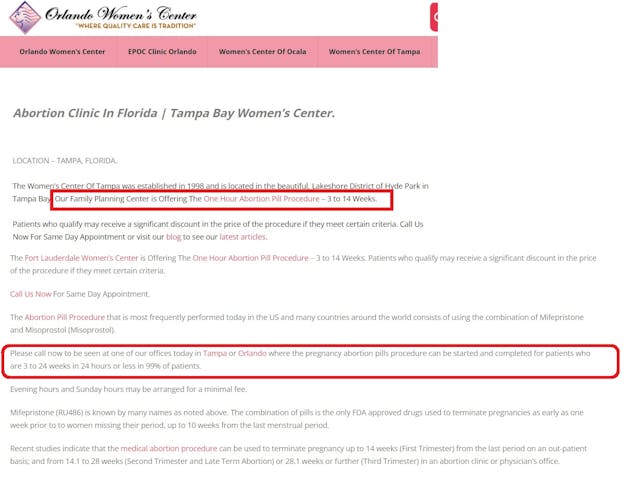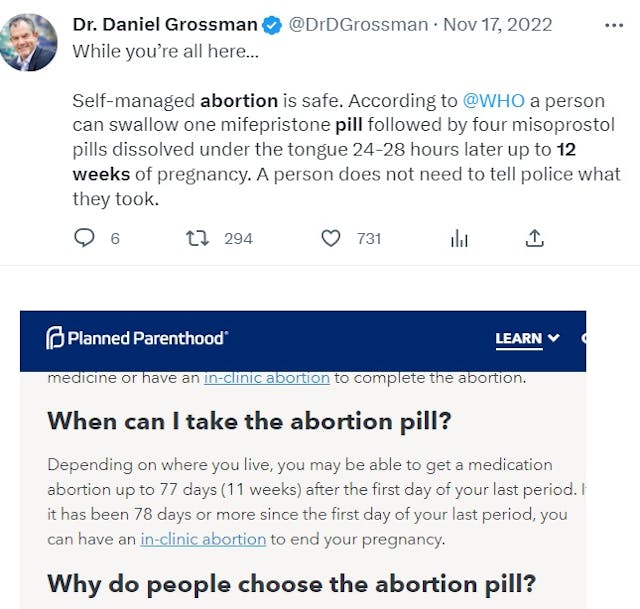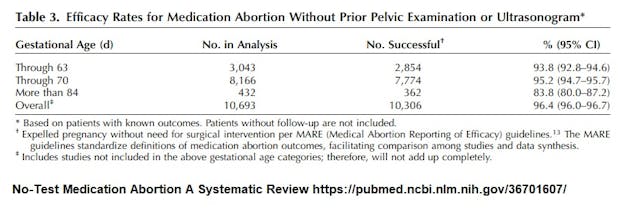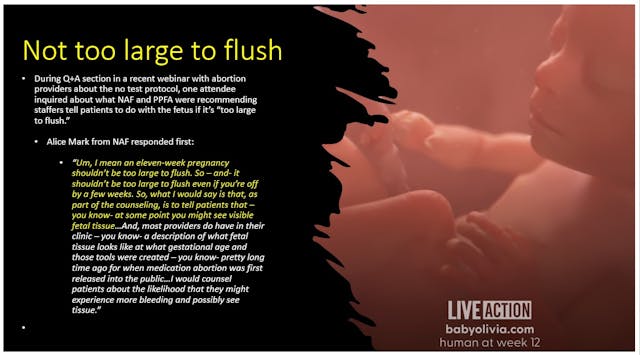
Analysis
Judge denies anonymity for victim of forced abortion
Cassy Cooke
·
Abortion Pill·By Carole Novielli
BAD ACTORS: Abortion industry openly ignores FDA’s abortion pill use limits
Editor’s Note: This article is the first installment in a series. Subsequent articles in the series can be read here: Bad Actors #2, Bad Actors #3, Bad Actors #4, Bad Actors #5, Bad Actors #6, Bad Actors #7.
Why is the abortion industry purposely ignoring the U.S. Food and Drug Administration’s (FDA) abortion pill regulations? This is a question that no one except the pro-life movement seems to be interested in asking, despite the very real risks to women.
This article, the first in a series, will explore the well-known fact that the abortion industry is prescribing the abortion pill regimen past the FDA’s approved 70 days (ten weeks) gestation. This regulation is one of many being ignored by abortion industry insiders, despite the known risks of the abortion pill regimen mifepristone and misoprostol, even when used under the strict guidelines laid out by the FDA’s REMS safety system. In addition to prescribing the drugs past 70 days, the abortion industry is instructing women to take the drugs off-label, is failing to properly date a pregnancy or rule out dangerous ectopic pregnancy before prescribing the drugs, is spending little to no time at follow-up, and much more.
While the FDA-approved limit for the chemical abortion pill regimen is 70 days (10 weeks), women are being prescribed the regimen well into the second trimester of pregnancy. For example, the Orlando Women’s Center abortion facility tells clients online, “Our Family Planning Center is Offering The One Hour Abortion Pill Procedure – 3 to 14 Weeks.” In addition to the egregious disregard for the FDA’s gestational limit, there is no “one hour” protocol approved by the FDA.
But it gets worse.
The abortion chain also claimed on a separate page, “Please call now to be seen at one of our offices today in Tampa or Orlando where the pregnancy abortion pills procedure can be started and completed for patients who are 3 to 24 weeks in 24 hours or less in 99% of patients.”

Planned Parenthood states on its website: “Depending on where you live, you may be able to get a medication abortion up to 77 days (11 weeks) after the first day of your last period.” On a separate page, the abortion corporation writes, “You can use abortion pills (also called medication abortion) up to 77 days (11 weeks) after the first day of your last period.”
Cedar River Clinics also offers the pills through eleven weeks of pregnancy as does the University of California San Francisco (UCSF). Dr. Daniel Grossman, an abortionist who has been behind multiple abortion pill-related clinical trials, openly promotes use of the abortion pill through 12 weeks.

Dr. Linda Prine told Vox News, “The pills are approved by the FDA for up to 10 weeks and by the World Health Organization for up to 12. Most of the time, though, they’ve been used in our country under eight weeks; something like 75 percent to 80 percent of people using pills were using them under eight weeks pre-Dobbs. But now, they’re using them whenever they can get them. And sometimes that is quite a bit later. Sometimes it’s 14 weeks, 18 weeks. And so we get calls from people completely freaked out, crying, sobbing.” (emphasis added)
Additional examples can be seen in the image below:
Article continues below
Dear Reader,
In 2026, Live Action is heading straight where the battle is fiercest: college campuses.
We have a bold initiative to establish 100 Live Action campus chapters within the next year, and your partnership will make it a success!
Your support today will help train and equip young leaders, bring Live Action’s educational content into academic environments, host on-campus events and debates, and empower students to challenge the pro-abortion status quo with truth and compassion.
Invest in pro-life grassroots outreach and cultural formation with your TRIPLED year-end gift!

A systematic review revealed that when the abortion pill is used at 12 weeks (84 days), the failure rate rose to about 16%, an increase of nearly 12% from the failure rate when used before the approved FDA limit of 70 days.
Authors of the study, entitled “No-Test Medication Abortion: A Systematic Review,” found the following:
For patients with pregnancies at less than 70 days of gestation (n58,166), the [abortion pill regimen’s] efficacy rate was 95.2% (95% CI 94.7–95.7%).
For patients with pregnancies at more than 84 days of gestation (n5432), the [abortion pill regimen’s] efficacy rate was 83.8% (95% CI 80.0–87.2%).

The ability to accurately assess gestational age is part of the FDA’s REMS (Risk Evaluation and Mitigation Strategies) safety requirements for all prescribers of the abortion pill. Yet, a medical director with the National Abortion Federation (NAF) suggested in the Q+A section of a webinar released during the Covid-19 pandemic, that she was unconcerned about verifying the gestational age of the fetus unless the baby might be too large to flush.
Alice Mark, NAF’s Medical Advisor stated in part:
Um, I mean an eleven-week pregnancy shouldn’t be too large to flush. So – and — it shouldn’t be too large to flush even if you’re off by a few weeks. So, what I would say is that, as part of the counseling, is to tell patients that – you know — at some point you might see visible fetal tissue…
Women self-managing their abortions have been advised to sit on a toilet and then flush their dead child into the sewer system. As a result, women are now expressing trauma after seeing recognizable fetal body parts of the babies they are aborting.

Studies indicate that women seeking use of the abortion pill frequently underestimate the gestational age of their pregnancy and even the pro-abortion American College of Obstetricians and Gynecologists (ACOG) has stated that “It has been reported that approximately one half of women accurately recall their [last menstrual period] LMP.”
In addition, industry statistics show that the failure rates for the abortion pill regimen increase as the gestational age of the preborn baby increases. Yet, the abortion pill is being used well into the second and even third trimester of pregnancy — and as a result, a 31-year-old woman who was 21 weeks (19 weeks post-fertilization) pregnant died after she was prescribed the abortion pill in Indiana.
The authority to revoke abortion pill prescribers’ rights lies in the hands of the manufacturers — Danco and GenBioPro — which do not seem willing to place the safety of women over profits. Perhaps it is time for the FDA to step in to enforce its own approved regulations.
Live Action News is pro-life news and commentary from a pro-life perspective.
Contact editor@liveaction.org for questions, corrections, or if you are seeking permission to reprint any Live Action News content.
Guest Articles: To submit a guest article to Live Action News, email editor@liveaction.org with an attached Word document of 800-1000 words. Please also attach any photos relevant to your submission if applicable. If your submission is accepted for publication, you will be notified within three weeks. Guest articles are not compensated (see our Open License Agreement). Thank you for your interest in Live Action News!

Analysis
Cassy Cooke
·
Politics
Bridget Sielicki
·
Human Interest
Andrea Trudden
·
Abortion Pill
Carole Novielli
·
Abortion Pill
Carole Novielli
·
Abortion Pill
Carole Novielli
·
Abortion Pill
Carole Novielli
·
Investigative
Carole Novielli
·
Abortion Pill
Carole Novielli
·
Investigative
Carole Novielli
·